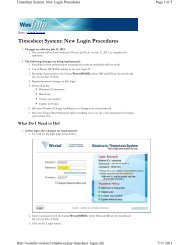The Addiction Behaviors Checklist: Validation of a New ... - Westat
The Addiction Behaviors Checklist: Validation of a New ... - Westat
The Addiction Behaviors Checklist: Validation of a New ... - Westat
Create successful ePaper yourself
Turn your PDF publications into a flip-book with our unique Google optimized e-Paper software.
344 Wu et al.Vol. 32 No. 4 October 2006Angeles Veterans Affairs (VA) HealthcareSystem.This study was approved by the local institutionalreview board. Data were collected as part<strong>of</strong> a larger data collection effort following patientswho were receiving long-term opioidmedication treatment over the course <strong>of</strong> oneyear. Participants visited the chronic pain clinicon a monthly basis in order to refill their opioidprescriptions. During the course <strong>of</strong> thesevisits, participants received various assessmentsreviewing their levels <strong>of</strong> pain over the course <strong>of</strong>the month and other areas related to potentiallyproblematic medication use. Participantswere asked to give signed consent prior to enrollmentinto this research study.Measures<strong>Addiction</strong> <strong>Behaviors</strong> <strong>Checklist</strong>. <strong>The</strong> development<strong>of</strong> ABC items was based upon an extensivereview <strong>of</strong> the relevant literature, 3,7,8,10,16,17 withan overriding aim to keep the tool concise,easy to complete, and otherwise useful ina busy clinical setting. Integrating observablebehaviors identified in and across the work <strong>of</strong>published experts on indicators <strong>of</strong> addictionin chronic pain patients resulted in the synthesis<strong>of</strong> items for the ABC (Appendix). <strong>The</strong> fullset <strong>of</strong> 20 items initially selected was used inall the analyses presented in this paper. Allbehaviors tracked in the ABC reflect thosesuggested in the consensus document by theAmerican Academy <strong>of</strong> Pain Medicine,the American Pain Society, and the AmericanSociety <strong>of</strong> <strong>Addiction</strong> Medicine. 10<strong>The</strong> tool was designed to be administered inan interview format and scored based uponthe participant’s responses to questions, the interviewer’sobservations <strong>of</strong> displayed behaviorsduring the session, and pertinent informationgathered from medical chart review. Itemswere classified into two major categories: 1) addictivebehaviors noted between visits (e.g.,‘‘patient running out <strong>of</strong> medications early,’’‘‘receiving narcotics from other providers’’)and 2) addictive behaviors observed withinthe visit (e.g., ‘‘patient appearing sedated,’’‘‘patient expressing concern about future availability<strong>of</strong> narcotic’’). In addition to these twomajor categories, another question wasincluded that could be used if the patient’sfamily members were present in session(‘‘significant others express concern overpatient’s use <strong>of</strong> analgesics’’). Family memberswere rarely present within the setting <strong>of</strong> thecurrent data collection, therefore producinginsignificant influence on study results. Thisitem was retained in the instrument, however,because this information might be more availablewithin other medical settings. A total <strong>of</strong> 20items were included in the instrument, with dichotomousresponse scoring. Each affirmativeresponse was counted as one point, and pointswere added to calculate the total score, consequentlyresulting in scores ranging from 0 to20. While some <strong>of</strong> the items on the ABC areclearly based on patients’ reports and henceare subject to reporting bias, the primary emphasis<strong>of</strong> the scale and item scoring is on observablebehaviors or objective informationderived from the patient or other sources toindicate opioid misuse. Participants wereassessed on a monthly basis using the ABC.Prescription Drug Use Questionnaire. To evaluateconstruct validity for the ABC, the PrescriptionDrug Use Questionnaire (PDUQ) 16 wasadministered to all subjects at the 4-monthclinic visit. Unique in that scores have beencross-validated with clinical expert diagnosis<strong>of</strong> addiction, the PDUQ consists <strong>of</strong> 39 itemsevaluating five different domains <strong>of</strong> problematicopioid analgesic use in chronic pain patients,including the characteristics <strong>of</strong> thepain condition, opioid use patterns, social/family factors, familial/personal history <strong>of</strong> substanceabuse/addiction, and psychiatric history.Initial analyses <strong>of</strong> PDUQ scores providesuggested cut-<strong>of</strong>f values indicative <strong>of</strong> the diagnosis<strong>of</strong> substance abuse and substance dependence.16 Since it includes historical data, thePDUQ was developed primarily to assess addiction(or addiction risk) at a single time pointand, therefore, is not a redundant measurewith the ABC. However, both measures dooverlap in their aim to measure the construct<strong>of</strong> current addiction behaviors and thusshould show moderate positive correlations.Global Clinical Judgment. A common criterionvariable in studies <strong>of</strong> opioid misuse is an expertclinician’s global judgment. 14,16 For thecurrent study, subjects were rated at each visitby their treating pain clinician on a dichotomousglobal question (‘‘Do you think patient







